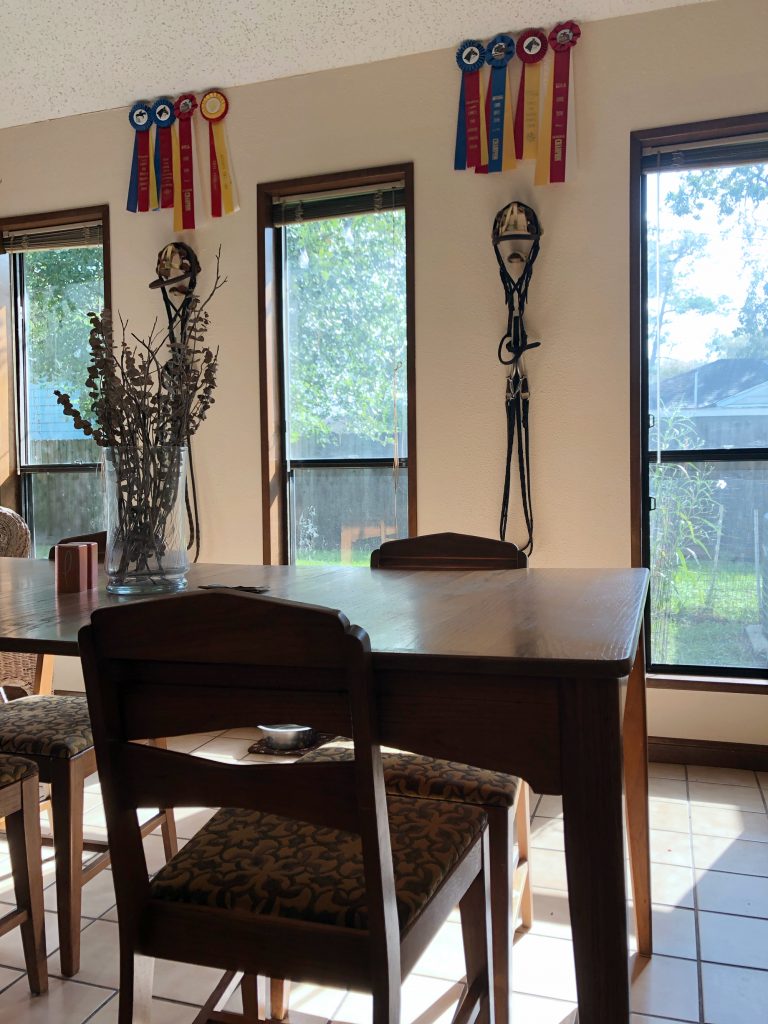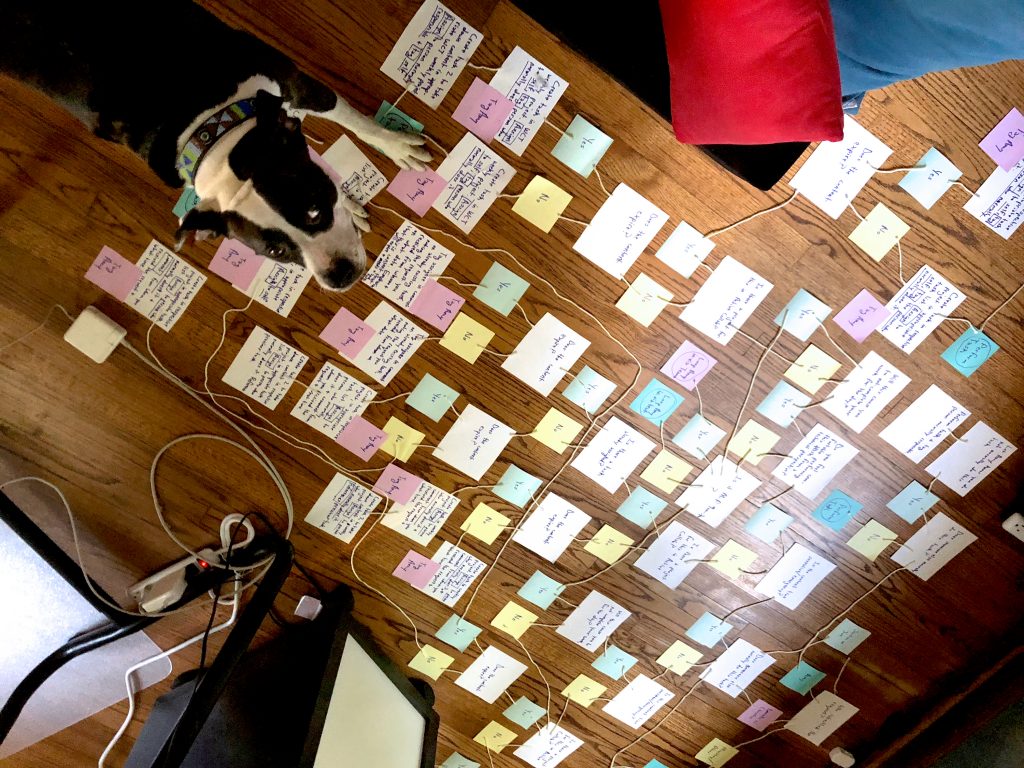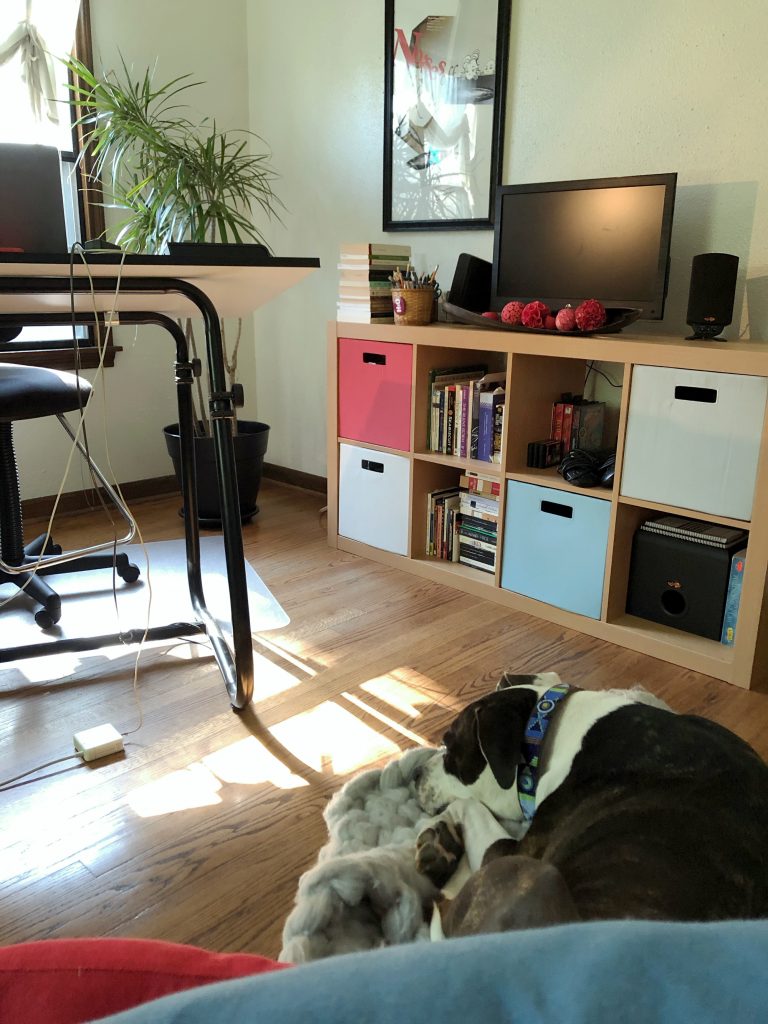
Amy Heidbreder
Blogger and Freelancer
Amy is a professional web content manager in megachurch world and a humble amateur equestrian. Follow her adventures of praying and riding. Available for freelance.
Habitating in a Multi-Functional Space
If you’re anything like me, your living space is serving a boundless variety of functions, especially during the COVID-19 pandemic. It’s a classroom, an office, a restaurant, a movie theater, a tack room, an oasis, and a building for every essential need you have.

I’m single, living in a modest, older home, with a dog, and I own a horse. The dog has toys. The horse has tack. The previous horse I rode had tack. The horse before them had tack, and you don’t want to throw any of it away, because you never know when that extra set of standing wraps or random elevator bit stowed away in the back of the closet might come in handy again. And they will come in handy again. PSA: part of being a horse person is amassing a collection of bits. So, where to put them?
During the COVID-19 pandemic I have been working from home, so in addition to a tack room, my home now has an office. You would think with all this cumulating horse stuff, I might be distracted, but I have been able to be wildly productive at home, even amongst the piles of leather and toys.
Another thing about my lifestyle is that it is relatively free of the normal entertainment that average people partake in, like eating out or going to the movie theater. I can’t afford to just go eat out willy-nilly. My budget is very tight. I dine out maybe once every other month. My home is my entertainment, my oasis, and believe it or not, I love it! Admittedly, my personality may have a little to do with me liking to stay in, as I’m an introvert, but even introverts can get stir crazy. So, how did I make out of an old home, a multi-functional space I love to be in and can be highly productive in? Here’s 5 tips for creating a great multi-functional space, even if it’s small:
1. Clear out the junk.
Your space is too small to be hoarding. I offloaded hundreds of pounds of junk I had accumulated since I was a kid. It’s hard. I was an art major, and every little neat find was a potential idea, so I collected all these knickknacks and trinkets. I had drafts upon drafts and sketches of hand done work that I fiercely clung to like a security blanket. Every project had a pile of sketches or trashed ideas, cut paper, color swatches, all rolled up, taped together and labeled. I didn’t throw ANYTHING away, thinking maybe I can use it in the future.
Throw it away.
Now let me clarify, I don’t recommend just randomly picking a huge pile of stuff and carrying it out to the curb. I do recommend going through everything and assessing every item’s value before trashing or recycling it. It will take you a while. Don’t expect this to be a quick process.
When clearing out junk, I went through every item in detail before deciding to throw it away, recycle it or donate it. There were these binders I hung onto of notes from every class I took in school, dating back to Middle School—binders that still contained print outs of original assignments, grades and report cards. I went through every binder, every page and picked out the most memorable content or notes I wanted to keep. The rest of the papers, I carefully separated from the binder and placed in a pile for recycling. The binder, if in good shape I put in an office supply pile. The rest I trashed. Most were too old and beat up to keep.
When you clear junk in a detailed, methodical way, it feels good. You don’t look back and stressfully wonder if you threw away something you shouldn’t have. Clearing junk can be extremely freeing. An uncluttered space is the first step in creating a lovable space.

2. Find your focus.
Here, I want to address a few principals for arranging a room that worked for me.
- Purpose:
Assign a purpose to each room and modify the room around that focus. I had roommates that departed, leaving me with an empty back bedroom. The room is a little smaller than an average horse stall, maybe 11ft x 11ft. I decided I wanted to make of the room a studio/work space and guest room. So, my intent from the beginning was to create a multi-functional space. The primary use of the room would be a studio and that would be my main focus. - Prioritize Purposeful Furniture as Focal Points:
You don’t have to go out and buy all new furniture to create a new vibe in a room. Work with what you have, just choose an arrangement. I already had a drafting table, so I started with that for my studio. I could make it my workstation and the focus around which the room revolved. Plus, it was the largest piece of furniture in the room, so it made sense to start there. I first deciphered where I wanted to sit in the room when I worked. I chose an angle that gave me visibility into the living room and a view of the tv. I like the television as background noise or I use it to play music. I also picked a location I felt made me comfortable and focused. Working was to be this room’s primary purpose so first and foremost, I wanted make sure the room did just that, worked. The secondary purpose as a guest room was a little more difficult to accommodate. The room was too small to have a bed and a drafting table cohabitating, so I got rid of my roommate’s bed frame and replaced it with a folded chair that unfolds into a memory foam mattress. I mainly prioritized those two items in the room. The rest of the furniture like bookshelves and cabinets I found a space for next. - Measure Everything:
One of the most annoying things is purchasing a piece of furniture and it doesn’t fit in the room. Before just lugging stuff into a room and getting carried away shopping online, measure every major piece of furniture you plan to bring to the room and tape off on the floor where you plan to place it. Before you purchase a piece of furniture, look at the listed dimensions online. Does it fit? Can you walk between your desk and bookcase to get out of your nook? Do you have room to work? Also take into consideration measuring how items relate to one another, such as the distance they sit away from a corner. This is getting a little more into design and less functional, but I like to view the room like it’s on a grid. Items don’t look out of place if they relate in measurement to another item in the room. When it comes to design, respect the grid. That’s a blog topic for another day. - Tie the Color into the Room’s Purpose:
You can change the entire feel of a room DRAMATICALLY with just a can of paint. You got to put a little work in though. Maybe I’ll write a future blog about painting your own home and tips on color choices. The main thing here is focus. Does the color take away your ability to do what the room is meant for? My studio space used to be orange. The warm tone had no contrast against the warm wood and it annoyed the crap out of me. I knew I had to change it. I couldn’t get work done in an annoying room.
In deciphering all of the above principles, remember the focus of the room. You have to be able to accomplish said purpose of this room and focus.
3. Get creative with storage.

If you’re like me, you live in a not-so-huge space. You can’t fit everything that needs storing in a closet, but that’s okay. Storage can be out in the open and decorative. Fabric boxes to hide small items aren’t all that expensive, and your choice of color can help bring the room together even more.
Maybe some of your tack can become decorative. My kitchen doubles as a tack room. Storage can be duel faceted. It doesn’t have to be invisible. It can actually be beautiful.
There is this old broken-down piece of furniture I inherited. I don’t know who it belongs to. It was in the shed behind my current home in the backyard when I moved in. It’s missing drawers. The handles are rusted, but it became a living room centerpiece and a makeshift toy box for my dog where she can serve herself. Get creative with storage! Even dog toy storage doesn’t have to be hidden.
4. Find ways to accommodate your pets and kids.
Sometimes your idea is not your kid’s or your pet’s idea. They are independent little thinkers too, but even with a kid or a dog hanging around, you still have to get work done and find your peace.

While, I don’t have a kid, I do have a dog who can be loud, disruptive and much of the time wants to be glued to my side. That affects my ability to use my studio space effectively. The loudness usually involves a spray bottle. I don’t know if that’s exactly good parenting for a human child, but you could try it I guess. 😉 My dog’s need to be close I accommodated with making space on the fold up guest bed in the studio. During this work from home season, that guest bed has become her bed. I allow her to be in my space and it keeps her quieter. Most of the time, she sleeps there nearly all day.
Little thoughts like that worked into your room designs might lessen your pet’s anxiety and make for a much more productive work space. Let your children know you’re thinking about them and have them worked into the framework of your room design at a basic and fundamental level, especially if they have a desire to be present in your space.
They need peace too, so they don’t bother you.
5. Don’t let clutter accumulate and clean every once in a while.
Now that you’ve done all this exhausting work, don’t let clutter creep back into your life. Be good about maintaining your space and clean every once in a while!